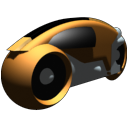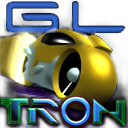Tron (video game)
| Tron | |
|---|---|
| File:Tron Video Game. Lightcycles.png Screenshot of Light Cycles subgame | |
| Developer(s) | Bally Midway |
| Platform(s) | Arcade game, Xbox Live Arcade |
| Release | 1982 |
| Genre(s) | Arcade video game |
| Mode(s) | Single player or 2 players alternating |
| Arcade system | Midway MCR II |
Tron is an coin-operated arcade video game manufactured and distributed by Bally Midway in 1982. It is based on the Walt Disney Productions motion picture Tron released in the same year. Events from this science fiction film were the inspirations for four subgames of which the game consists. It features some characters and equipment known from the film, eg the Light Cycles, battle tanks, the Input/Output Tower. The game earned more than the film's initial release[2].
In 1983, Midway released the sequel arcade game Discs of Tron, which was inspired by the disc throwing combat sequence of the film. Another sequel followed in 2003 with the computer game Tron 2.0.
Description
Arcade cabinet
Tron was distributed in three types of cabinets: the standard upright, the mini upright, and the cocktail (table) version. The upright cabinet is designed as movie tie-in. It has, as a special feature, two blacklights and fluorescent lines painted on, resembling the blue, red etc. circuit lines from the film Tron. In a darkened room or arcade the lines glow.
All cabinets feature an 8-way joystick for moving, with one button for firing or speed control, and a rotary dial for controlling the direction of the fire (a setup also used in Kozmik Krooz'r another Midway game). The game can be played by one player or by two alternating players as the controls are made for only one player at a time[1].
Gameplay
The player in the role of Tron has to beat four subgames, each at 12 increasingly difficult levels. All four segments of one level must be completed before continuing with the next level.
1. I/O Tower
This segment of the game mimicks Tron's quest to enter the Input/Output tower from the motion picture. In the arcade game, the player must destroy large numbers of Grid Bugs with Tron's disc and clear a path to the flashing circle, which must be entered before a timer runs out to complete the section.
2. MCP Cone
This area imitates Tron's final battle against the MCP. The game's interpretation has the player destroying a multicolored wall in front of the MCP cone and getting by the wall, into the cone. A 1000 point bonus is awarded for completing the level, and an additional 1000 points is given for destroying all blocks of the wall.
3. Battle Tanks

The Battle Tanks subgame is not strictly based on film events, but the tanks are taken from there. The player must guide Tron's red tank through a maze and destroy several blue tanks or red recognizers controlled by the computer. This must be done without taking any hits from enemies. If the player drives into the purple diamond in the center of the maze, the tank is warped to a random area of the maze. A bug in the game results in a cheat option. When the player's tank is not touching the white line in the corridors, it can not be hit by the enemy's fire, but it can still be rammed by enemy tanks.
4. Light Cycles
This game is well known and associated with the Tron franchise. The player must guide a blue Light Cycle in an arena, while avoiding the walls and trails (walls of light) created by his/her Light Cycle and that of his/her opponent. The player must maneuver quickly to force opponents to run into walls. The enemy cycles have a fixed behavior pattern for each level and the player can find a pattern which will defeat them every time on this level. The Light Cycle colors from the film are reversed in the game, where the player drives the blue cycle and the enemy the yellow cycle. In the film, the protagonists' cycles are yellow, orange, and red, and the enemies' are blue.
5. Recognizers
These floating vehicles, colloquially referred to by the public as "stompers" for quite some time (the designation "recognizers" was used very, very sparingly in the film and many viewers might have therefore been unaware of the proper name) take the place of the tanks at higher levels in the tanks game. (In the movie, the Recognizers were the vehicles that attempted to stop the light cycles from escaping the game grid by "stomping" on them, and one of these vehicles was also the type of machine that Flynn "resurrected" with his user powers.)
Recognizers do not fire at the player's tank at all but move a high speed, relentlessly converge on the player's location, and each still require three shots to destroy them.
Level keywords
Each of the 12 difficulty levels has a different keyword. They all relate in some way to computing, and most of them are programming languages. The keywords are, from lowest difficulty to highest: RPG, COBOL, BASIC, FORTRAN, SNOBOL, PL1, PASCAL, ALGOL, ASSEMBLY, OS, JCL, USER[1].
Development
The lead programmer was Bill Adams[3] [4]. The original high score in all of the games was programmed with his initials "BA". He also included his children's initials.[citation needed]
Reception and criticism
Tron was awarded "Coin-Operated Game of the Year" by Electronic Games Magazine[3].
Legacy
Sequels
- Discs of Tron (1983): arcade game which was originally intended as a fifth segment of Tron but was left out because programming was not finished in time[1]. In it, the player engages in disc throwing combat, similar to the film sequence.

- Tron 2.0 (2003): first-person shooter computer game sequel with a new Light Cycle design by Syd Mead who had also designed them for the film.
- Tron 2.0 Killer App (2004): a port of Tron 2.0 as videogame to Xbox and Game Boy Advance with significant changes to the game. The Xbox version features new multiplayer modes. In the Game Boy Advance version there are Tron and Discs of Tron included.
Other
- Videogame series for Mattel's Intellivision console:
- Tron: Deadly Discs (1982): based on the disc throwing combat in the film Tron. Has also been released for Atari 2600[5].
- Tron Maze-a-Tron
- Tron Solar Sailer

- Open-source computer games released under GNU General Public License via download for multiple platforms:
- Armagetron Advanced: based on the Light Cycle game from the film Tron.
- GLtron: based on the Light Cycle game from the film Tron.
- KTron: another game based on the Light Cycle game from the film Tron. KTron is one of the KDE Games distributed as part of the K Desktop Environment (KDE).
In popular culture
- Kingdom Hearts II, a Playstation 2 game which includes Disney characters, has a Tron-based world[6].
- Erik Hermansen, creator of the little known but well-liked puzzle game DROD (or Deadly Rooms of Death) included a tribute to Tron in one of the rooms in Level seven, using Serpents as the Light Cycles.
- The Light Cycle game was featured in the cartoon Family Guy. Peter is shown driving a light cycle, and recognizing the enemy as a friend from high school. His friend then takes a right and cuts Peter off, ending the game.
References
- ^ a b c d "Tron Arcade" (Web). www.3gcs.com. Retrieved 2007-09-15.
Information about technical specifications, cabinets, gameplay, level keywords.
{{cite web}}: Cite has empty unknown parameter:|coauthors=(help); External link in|publisher= - ^ "Trivia for TRON" (Web). www.imdb.com. Retrieved 2007-09-15.
{{cite web}}: Cite has empty unknown parameter:|coauthors=(help); External link in|publisher= - ^ a b "About the technology author(s)" (Web). IBM Multimodal Annotation Tool. www.alphaworks.ibm.com. 2002-08-09. Retrieved 2007-09-15.
{{cite web}}: Cite has empty unknown parameter:|coauthors=(help); External link in|publisher= - ^ "Tron at arcade-history" (Web). www.arcade-history.com. Retrieved 2007-09-15.
{{cite web}}: Cite has empty unknown parameter:|coauthors=(help); External link in|publisher= - ^ "Tron: Deadly Discs" (Web). www.mobygames.com. Retrieved 2007-09-15.
{{cite web}}: Cite has empty unknown parameter:|coauthors=(help); External link in|publisher= - ^ "The Cylon Alliance - Tron" (Web). www.cylon.org. Retrieved 2007-09-15.
{{cite web}}: Cite has empty unknown parameter:|coauthors=(help); External link in|publisher=
